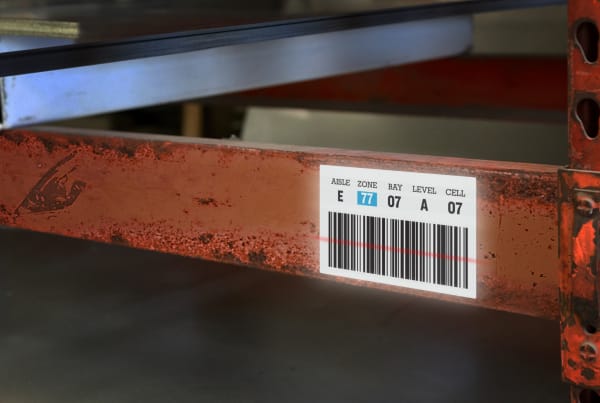7 Tips to Increase Warehouse Efficiency after Your Busy Season

Your team worked hard, and beat the rush, now what?
During your peak season, there may not be time to stop and evaluate warehouse strategies or implement a new warehouse layout. However, areas for improvement and/or inefficiencies are often brought to light when your warehouse is operating at capacity.
Right after your busy season is the best time to reevaluate and implement warehouse improvement techniques. Here’s 7 warehouse efficiency tips that can help you, not only bounce back from the chaos of the season, but also set you up for greater gains during the next peak.
1) Get back to basics— clear the clutter with 5S/6S
When operating at capacity small organizational tasks are often set aside and can build up. Not to mention, the additional supplies, tools, equipment and safety stock that are often brought in to keep operations moving smoothly during the peak season.
Once operations are back to “business as usual,” clearing the seasonal clutter from your warehouse should be the top priority. Go back to the basics of 5S/6S principles and focus on sorting items and setting them in order.
2) Implement a data-driven inventory review process
Review the data from your inventory management software or and decide if you can reduce or eliminate safety stock. Perhaps getting suppliers to deliver smaller quantities more often. Some key metrics to look at are: average days to sell inventory, inventory turnover rate, return on investment (ROI) for holding the inventory, diminishing ROI over time and gross profit after the cost to make, hold and sell the inventory.
Once you’ve determined the thresholds for the above metrics, it will be easier for your team to trim down inventory back to non-peak levels. You can also set automatic alerts to review inventory when thresholds are reached to help keep your warehouse lean until it’s time to build up to the next busy season.
3) Review your warehouse layout for hidden opportunities
Now that you’ve removed excess seasonal inventory, supplies, tools and equipment you can optimize your warehouse space. Instead of expanding the footprint of your warehouse, re-organize your warehouse layout to make the most of the space in terms of efficiency and storage
Here are some great warehouse strategies for optimizing space:
- Take advantage of vertical space.
- Reduce empty rack space by standardizing bins to fit the rack height.
- Identify underutilized space. For example, is there room for hanging shelves above a conveyor belt or adding a storage trailer for seasonal supplies in your lot?
- Reduce travel time by making the most-picked items more accessible (i.e. store items frequently sold together near to one another and high-volume items near the front of the warehouse).

4) Streamline with warehouse management system software
After your busy season is the ideal time to implement or upgrade warehouse management software (WMS). There’s plenty of time and cash flow to put towards optimizing warehouse efficiency by determining the most effective use of both space and labor using WMS.
For example, as you re-evaluate your warehouse layout, WMS can help you determine material, product and equipment locations that optimize the flow of your warehouse. WMS can also suggest the best routes and methods for picking or putting away.
5) Increase mobility with smartphones and tablets
There are pros and cons for using radio frequency scanners (RF guns) versus smartphones or tablets in heavy-duty environments like warehouses. While many argue RF guns versus smartphones as “either, or,” in reality, a combination of the two is likely to be the case in terms of increasing warehouse efficiency.
For example, RF guns are typically better for long-range scanning and are inherently more durable. As you optimize your warehouse layout by increasing use of vertical space, RF guns are extremely handy. On the other hand smartphones and tablets often require less training and can work as mobile workstations for warehouse managers and other employees.
WIFI enabled smartphones and tablets with durable cases provide warehouse managers and employees with a constant connection to inventory or warehouse management systems. No more heading back to the office for printed reports, data is accessible anytime and anywhere.
6) Update barcode labels to improve inventory management
Barcode labels allow workers to gather and store data much quicker and more accurately than manually recording data. Incomplete or incorrect scans from damaged or hard-to-reach barcodes can really slow down productivity and throw a wrench in warehouse efficiency and workflow.
Old peeling or taped-over labels should be replaced with durable barcode labels that are engineered for long-lasting performance in heavy-duty environments. Labels for hard-to-reach or vertical storage areas should be replaced with retro-reflective barcode labels to improve long-range scanning.
If you’ve already integrated mobile devices into your warehouse operations, you might consider switching to or adding QR codes in certain areas. QR codes can hold much more information and integrate seamlessly with camera-operated scanning on devices (versus scanning via reflected light).
7) Review and update your picking process
There are many picking processes to choose from including, single order, zone, batch and wave picking; what method works best really depends on the facility and is likely to change over time. The off season is the perfect time to lean on your WMS to help you determine the most efficient picking process for your warehouse.
You may even discover that it’s time to scale up and consider automating some or all of your picking process. Sorters and conveyors that can move product through your facility can greatly increase warehouse efficiency.
The Takeaway
The calm following your busy season is the best time to review, re-evaluate and re-organize your warehouse operations. Taking this time to increase warehouse efficiency is an investment your facility will reap all year long.
To learn more about organizing your warehouse using 5S/6S principles check out our free whitepaper with 5S/6S labeling solutions.
What is 5S/6S? A Simple Reference List of 5S (or 6S) Principles
Avery Introduces Laser-Printable Reflective Labels for Industrial Users